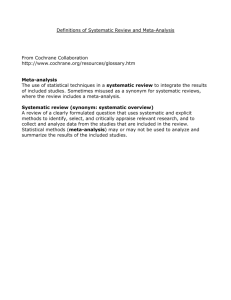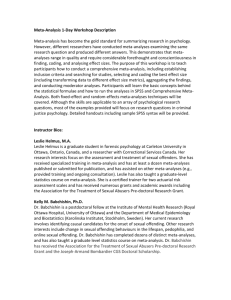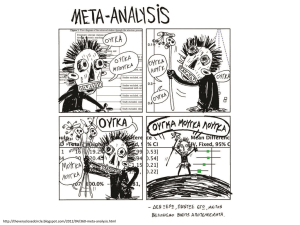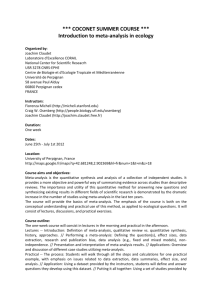PPTX
advertisement
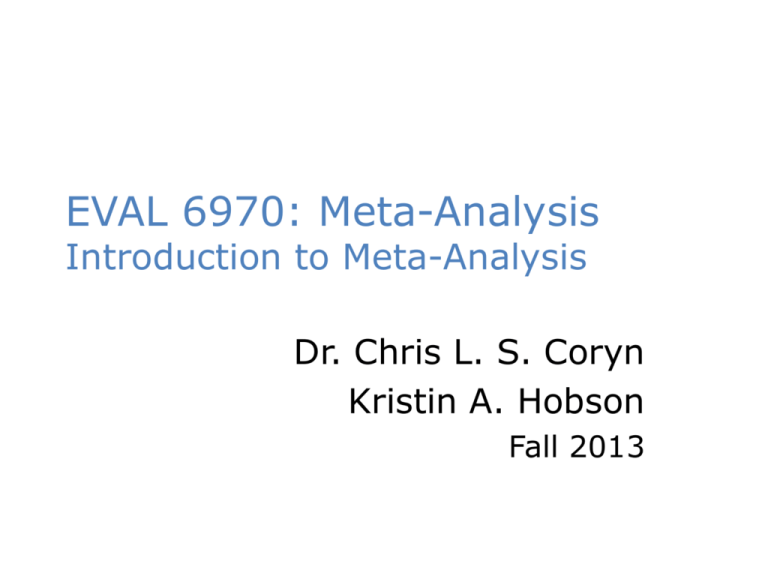
EVAL 6970: Meta-Analysis Introduction to Meta-Analysis Dr. Chris L. S. Coryn Kristin A. Hobson Fall 2013 Agenda • Course overview • An overview of and brief introduction to meta-analysis • Selection of working groups • In-class activity • Next meeting Required Textbooks • Bornenstein, M., Hedges, L. V., Higgins, J. P. T., & Rothstein, H. R. (2009). Introduction to meta-analysis. West Sussex, UK: Wiley. • Cooper, H., Hedges, L. V., & Valentine, J. C. (Eds.). (2009). The handbook of research synthesis and meta-analysis (2nd ed.). New York, NY: Russell Sage Foundation. Software Requirements • Comprehensive Meta-Analysis 2.0 – $95 for a one year lease at the student rate – $195 for a complete, unlimited license at the student rate Homework • Homework #1: Formulating a problem statement and reviewing the literature • Homework #2: Coding and storing studies for analysis • Homework #3: Computing effect sizes and standard errors from studies • Homework #4: Quantifying heterogeneity and publication bias Final Project • Final Project Part 1 (take home): You will execute and write-up a small meta-analysis • Final Project Part 2 (in class): You will give a 15 minute presentation of the meta-analysis completed in Part 1 Weighting of Components • • • • • • Attendance & participation (10%) Homework #1 (10%) Homework #2 (10%) 100% – 95% = A Homework #3 (10%) 94% – 90% = BA Homework #4 (10%) 89% – 85% = B Final Project (50%) 84% – 80% = CB 79% – 75% = C < 75% =F Instructional Format • Approximately 1 to 1 ½ hour lecture • Approximately 1 to 1 ½ hour in-class work with data sets and problems, or other types of activities Course Website and eLearning • Course Website – http://www.wmich.edu/evalphd/courses/eval6970-meta-analysis/ • • • • • Readings Homework Lectures Data sets Effect size calculators and meta-analysis spreadsheets • eLearning – Submit homework assignments and projects Introduction to Meta-Analysis Forest plot from a meta-analysis of the relationship between MMR and autism (study completed last time this course was offered) The Great Debate • 1952: Hans Eysenck concluded that there were no favorable effects of psychotherapy, starting a raging debate – 20 years of research and hundreds of studies failed to resolve the debate • 1978: To prove Eysenk wrong, Gene Glass (and colleague Smith) statistically aggregated the findings of 375 psychotherapy outcome studies – Concluded that psychotherapy did indeed work – Glass called his method “meta-analysis” Historical Origins • Ideas behind meta-analysis predate Glass’ work by several decades – Karl Pearson (1904) • Averaged correlations for studies of the effectiveness of inoculation for typhoid fever – R. A. Fisher (1944) • “When a number of quite independent tests of significance have been made, it sometimes happens that although few or none can be claimed individually as significant, yet the aggregate gives an impression that the probabilities are on the whole lower than would often have been obtained by chance” • Source of the idea of cumulating probability values Emergence of Meta-Analysis • W. G. Cochran (1953) – Discusses a method of averaging means across independent studies – Laid-out much of the statistical foundation that modern meta-analysis is built upon (e.g., inverse variance weighting and homogeneity testing) Logic of Meta-Analysis • Traditional methods of review focus on statistical significance testing • Significance testing is not well suited to this task – Highly dependent on sample size – Null finding does not carry the same “weight” as a significant finding • Significant effect is a strong conclusion • Nonsignificant effect is a weak conclusion Logic of Meta-Analysis • Meta-analysis focuses on the direction and magnitude of effects across studies, not statistical significance – Isn’t this what we are interested in anyway? – Direction and magnitude are represented by the effect size When Can You Do Meta-Analysis? • Meta-analysis is applicable to collections of research that – Are empirical, rather than theoretical – Produce quantitative results, rather than qualitative findings – Examine the same constructs and relationships – Have findings that can be configured in a comparable statistical form (e.g., as effect sizes, correlation coefficients, odds-ratios, proportions) – Are “comparable” given the question at hand Suitable for Meta-Analysis • Central tendency research – Prevalence rates • Pre-post contrasts – Growth rates • Group contrasts – Experimentally created groups • Comparison of outcomes between treatment and control/comparison groups – Naturally occurring groups • Comparison of spatial abilities between boys and girls • Rates of morbidity among high and low risk groups Suitable for Meta-Analysis • Association between variables – Measurement research • Validity generalization – Individual differences research • Correlation between personality constructs Effect Sizes: The Key • The effect size makes meta-analysis possible – It is the “dependent variable” – It standardizes findings across studies such that they can be directly compared Effect Sizes: The Key • Any standardized index can be an “effect size” (e.g., standardized mean difference, correlation coefficient, odds-ratio) as long as it meets the following – Is comparable across studies (generally requires standardization) – Represents the magnitude and direction of the relationship of interest – Is independent of sample size • Different meta-analyses may use different effect size indices The Replication Continuum Pure Replications Conceptual Replications • You must be able to argue that the collection of studies you are meta-analyzing examine the same relationship – This may be at a broad level of abstraction, such as the relationship between criminal justice interventions and recidivism or between school-based prevention programs and problem behavior – Alternatively it may be at a narrow level of abstraction and represent pure replications • The closer to pure replications your collection of studies, the easier it is to argue comparability Which Studies to Include? • It is critical to have explicit inclusion and exclusion criteria – The broader the research domain, the more detailed they tend to become – Refine criteria as you interact with the literature – Components of a detailed criteria • • • • • • • Distinguishing features Research respondents Key variables Research methods Cultural and linguistic range Time frame Publication types Method Quality Dilemma • Include or exclude low quality studies? – The findings of all studies are potentially in error (methodological quality is a continuum, not a dichotomy) – Being too restrictive may restrict ability to generalize – Being too inclusive may weaken the confidence that can be placed in the findings – Methodological quality is often in the “eye-ofthe-beholder” – You must strike a balance that is appropriate to your research question Searching Far and Wide • The “we only included published studies because they have been peer-reviewed” argument • Statistically significant findings are more likely to be published than statistically nonsignificant findings • Critical to try to identify and retrieve all studies that meet your eligibility criteria Searching Far and Wide • Potential sources for identification of documents – Computerized bibliographic databases – “Google” and “Google Scholar” internet search engines – Authors working in the research domain (e-mail a relevant Listserv?) – Conference programs – Dissertations – Review articles – Hand searching relevant journals – Government reports, bibliographies, clearinghouses Bibliographic Databases • Rapidly changing area • Get to know your local librarian! • Searching one or two databases is generally inadequate • Throw a wide net – Filter down with a manual reading of study abstracts Strengths of Meta-Analysis • Imposes a discipline on the process of `summing-up’ research findings • Represents findings in a more differentiated and sophisticated manner than conventional reviews • Capable of finding relationships across studies that are obscured by other approaches • Protects against over-interpreting differences across studies • Can handle large numbers of studies (this would overwhelm traditional approaches to research review) Weaknesses of Meta-Analysis • Requires a good deal of effort • Mechanical aspects don’t lend themselves to capturing more qualitative distinctions between studies • “Apples and oranges” criticism • Most meta-analyses include “blemished” studies to one degree or another (e.g., a randomized design with attrition) • Selection bias posses a continual threat – Negative and null finding studies that you were unable to find – Outcomes for which there were negative or null findings that were not reported Selection of Working Groups • Throughout the semester you may work individually or in small groups • This includes all in-class activities as well as homework and the final project (with instructor approval) • Groups should be no larger than 3 people so that everyone learns all of the statistical and non-statistical techniques Today’s In-Class Activity • Individually, or in your working groups, review the instructions for Homework #1 and begin discussing a research area or problem that you or your group might consider investigating for a meta-analysis – If you are in a group, determine who will be responsible for what specific tasks to complete Homework #1 • Conduct a brief search to determine if one or more meta-analyses have already been conducted and, if so, how recently • Write down the draft statement of problem or focal area and discuss with the class

